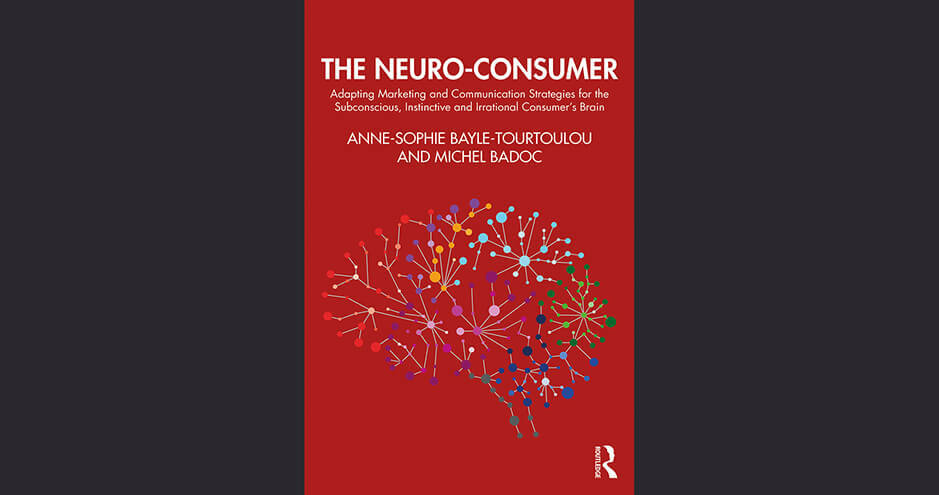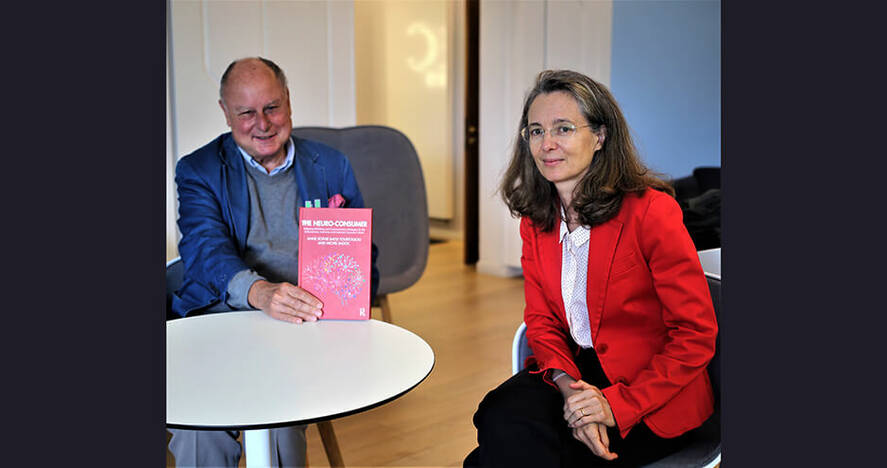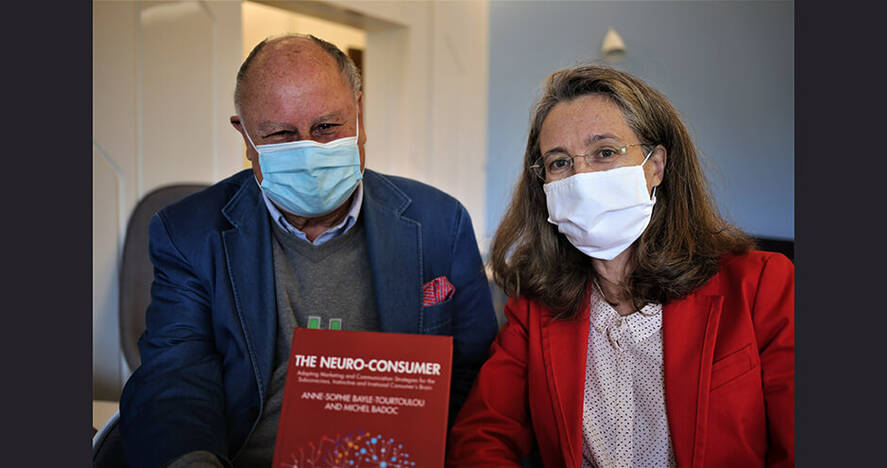Two HEC Paris Professors Bring Neuroscience and Marketing Closer Together
Marketing strategists and consumers are only beginning to understand the impact of the subconscious on purchasing decisions. Yet, neuroscientific research indicates it is hugely disruptive to rational decision-making. To dissect how and why this is the case, HEC Paris professors Anne-Sophie Bayle-Tourtoulou and Michel Badoc once again join forces to publish The Neuro-Consumer.

(© Routledge)
The Neuro-Consumer is a panoramic book. It associates the latest neuroscientific research and technological advances, with timeless reflections on Western philosophy, psychology and sociology. Anne-Sophie Bayle-Tourtoulou and Michel Badoc are two globally recognized specialists on this juncture between neuroscience and business, and their latest work describes in non-specialist terms their marketing journey into the mind. It is academically thorough and densely annotated, reflecting a decade-long exploration into advanced research in a nascent field. Using neuroscientific tools, the authors dissect how our five senses respond to marketing ploys and what new campaigns are being deployed by companies to further seduce them with their products.
At the same time, to the non-initiate, The Neuro-Consumer is a wonderfully entertaining read. It reminds this reviewer of books bringing linguistics alive, or condensing the world’s history, buoyed by hundreds of research and academic papers. There are fascinating insights, examples and anecdotes on almost every page. Want to understand how our second brain, a mass of neurons the size of a dog’s mind that’s hidden in our digestive tract, dictates our consumer choices based on a ‘gut feeling’? The role of the 100 trillion bacteria that crucially impact our internal equilibrium? The endogenous factors like age and gender and how they influence our consumer choices? Or how the secretion from neurotransmitters help researchers understand what neuro-consumers feel or experience when shopping? The Neuro-Consumer has easy-to-digest answers to all these questions – and so much more.
Pluri-disciplinary Approach
Researchers estimate that humans make around 35,000 conscious decisions a day. Yet, a growing number of studies are showing this figure to be shrouded by the number of choices guided by the subconscious mechanisms in the brain. Despite their dominance, our understanding of their role is woefully lacking. And marketing strategies, particularly in France, continue to resist integrating the impact these mechanisms have on consumer behavior. “In France we are very Cartesian, dominated by rationality and beliefs that we control all our decisions,” says Michel Badoc with a slightly resigned sweep of the hand. “Yet, neuroscience research shows that 80% of our activity is driven by our subconscious.”
The Emeritus Professor at HEC Paris has been collaborating with fellow-academic Anne-Sophie Bayle-Tourtoulou on the meeting of marketing, business and neuroscience for over a decade. They co-authored the highly-regarded Neuromarketing in Action seven years ago, and continue to collaborate in teaching marketing to HEC Paris students of all years. “HEC Paris professors drive research here in many different ways,” says Bayle-Tourtoulou who also holds academic responsibilities at the executive level. “There is the consumer-behavior research, with advanced work on eye-tracking, for example. And we encourage students to integrate several social science fields such as psychology and sociology into marketing strategies.”
Badoc adds: “We are at the forefront of a relatively new discipline in challenging times. At the start, we labelled our courses “neuromarketing” but quickly changed them to “neuroscience and marketing”. We’re not in the business of proselytizing for these techniques, we simply describe the tools and methods used, as well as the ethical and moral problems that need to be pondered over if you practice this kind of marketing.”
Forging True Company-Consumer Relationships
The 300-page book delves deeply into risks to this new breed, branded the “neuro-consumer-actor”, of subliminal manipulation. The authors make a strong appeal to companies for “strong moral and ethical rules” to govern the use of neuroscience in marketing. “These techniques address the brains and senses directly,” notes Bayle-Tourtoulou. “So, we ask firms: ‘What are your objectives in using these techniques?’ We believe most companies don’t want to deceive or manipulate their clients, however. In this age of the Internet, they have to develop very true relationships with consumers, based on more affective means. And you don’t do that through deceptive methods.”
Both academics stress the predominant roles that the state, education establishments and the media must play in safeguarding new generations against subliminal manipulation based on neuroscience: “We have to teach students very early on how the unconscious brain works to block insidious campaigns,” stresses Badoc. “And the media has to warn citizens that quick decisions are sometimes catastrophic because they are dominated by our subconscious.” Bayle-Tourtoulou believes rules governing real estate purchases – whereby mandatory time is given to reflect and retract - could be templates for day-to-day consumption: “The brain needs time to make rational decision. At night, for example, it classifies information, mulls things over while we’re sleeping. Consumers should be allowed to reflect, change their minds. More and more companies allow for the possibility of returning products, that’s a step in the right direction.”
Dangers in the 3.0 Era
The final chapter of The Neuro-Consumer is devoted to the breakneck speed at which the digital revolution is changing the brain’s perception. Only 30 years after the creation of the World Wide Web, the 3.0 “semantic web” - referring to the Internet of things (IoT) - is about to take the marketing world by storm. “We are moving into a world where “zapping” replaces logic and thoughts,” warn the authors. One of the main reasons for this, they say, is human brains are being “overloaded” with information from all quarters. The results are mapped out: “There is a risk of mystification and deceit. The concern for speed and the need to respond to the numerous appeals, for a brain that can only process one-fifth of the information received at a time, becomes the significant cause of errors of judgment.”
Combatting the negative fallouts of this zapping culture is one of the authors’ priorities. “There is a need to prioritize more,” insists Bayle-Tourtoulou. “Believe me, your time is precious in this reign of fast-food, speed-dating, speed-everything! We need to teach the new generations to take their time, organize it, reread what they are about to sign.” The Neuro-Consumer allows a wider public to better understand these stakes by stripping the latest research of its esoteric language and sharing hundreds of clear examples to illustrate how current neuroscientific knowledge helps to interpret the behavior of the consumer brain. “We hope that (this book) will lead to that knowledge being developed,” they conclude, “both for the consumers and for companies, with the objective of further improving the close relationship that already exists between them.”

